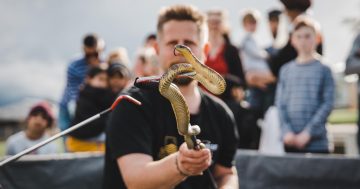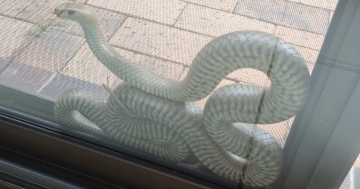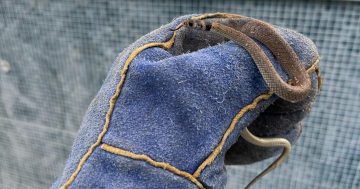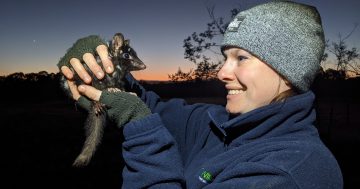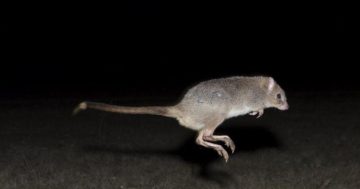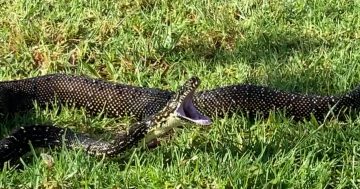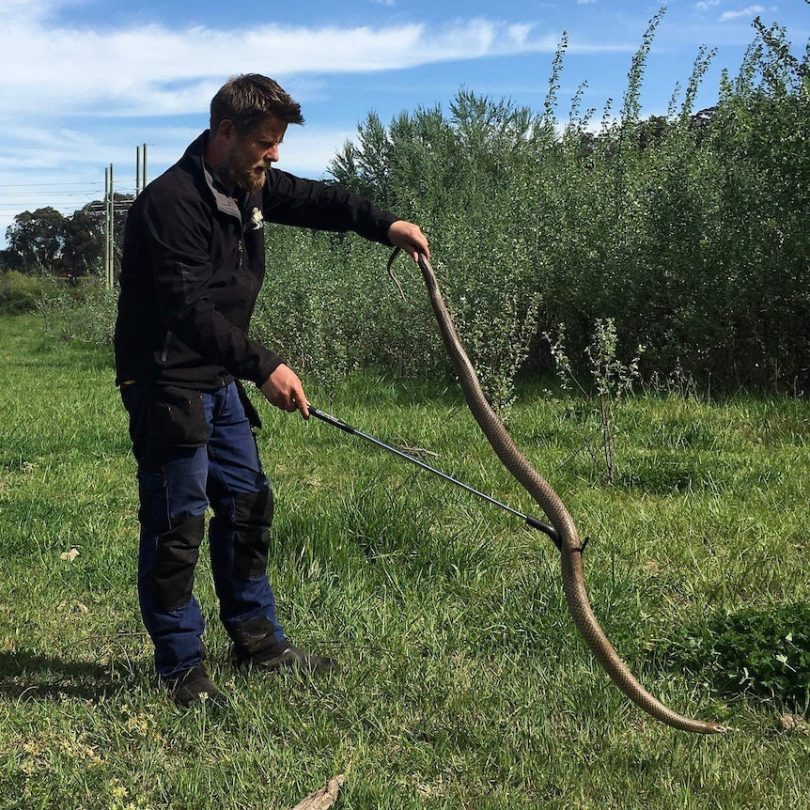
Academic and snake-tracker Gavin Smith with an Eastern brown he caught in Canberra. Photo: ACT Snake Removals.
Gavin Smith spends his days tracking down something that most of us are keen to stay away from – Eastern brown snakes.
An Associate Professor of Social Science at the Australian National University, Gavin also owns and operates ACT Snake Removals. Since 2021, he has been watching, finding and tracking the Eastern browns in a number of Canberra nature park locations.
But it’s Canberra’s favourite wildlife sanctuary, Mulligans Flat, where Gavin and his colleagues are setting their sights.
Inside Mulligans, the country’s largest single box gum grassy woodland area, somewhere, slithers Khan. Researchers aren’t supposed to have favourites, but it’s clear an exception has been made for this particularly large Eastern brown.
Gavin has developed a special relationship with “the big fella”.
“He’s a strong, healthy fellow,” Gavin said, “with plenty of personality. He’s about 1.6 metres long and by the end of the project we hope to be able to tell how much he has grown a year, his weight, that sort of really valuable information.”
By tracking snakes with tiny radio transmitters, Gavin is able to understand the reptile he reckons has had “a bad rap” with most humans.
“It’s probably because most people don’t see snakes often that they are branded sinister,” Gavin said. “It’s not surprising we are so shocked when we come across them.”
Originally from Scotland, Gavin said many of his family and friends believed him crazy to want to move to the other side of the world – the home of the world’s most venomous snakes and assorted other wildlife with bite.
“But I’ve always been passionate about wildlife,” he said. “Also, as a sociologist, I’ve always been interested in where fear comes from. The fear people have for snakes to me doesn’t seem proportionate to the risks some snakes pose.
“I’ve always wondered how we can make snakes cool because, for me, it’s a privilege to work with them.
“I owe snakes a huge debt of gratitude even if I do have to take a whack occasionally – I don’t take it personally.
“Through snakes, I feel more connected to the country here. I work with them daily, it feels like part of my integration into Australia.”
Gavin came to Australia in 2010. He describes it as happenstance, believing it was the right path for him.
He is a great advocate for snakes, believing that through this research people will be able to understand snakes more and thus reduce their fear.
In his Canberra project, where he is assisted by wildlife vet Dr Arianne Lowe and volunteers, Eastern browns are caught and then sedated briefly so the tiny radio transmitter can be implanted. It’s about the size of a small fingernail.
“It has to be tiny so it doesn’t affect the welfare of the snake in any way,” Gavin said. “Dr Lowe is incredible the way she can implant the transmitter so well – we couldn’t do a project like this without her.”
Gavin then works with volunteers at the Canberra nature reserves to track the snakes. Through this research, he hopes to learn valuable information about the reptiles and, in turn, how humans and snakes can learn to better live together.
Gavin hosts regular training sessions with volunteers at Mulligans and other nature reserves on how to track snakes.
“It is tough work,” he said. “It’s not like the snakes will be cruising down the street waiting for us to see them. After all the rain we’ve had they’ll be hidden in the thick grass, so there’s lots of footwork involved. But it is the most incredibly satisfying work, you get such incredible insight into their habitat.”
So why does a multi-talented academic with a string of global achievements to his name, travel from the other side of the world to spend his days tracking one of the world’s most dangerous reptiles?
“There are two reasons,” he said. “First, to get a better understanding of snakes. No-one knows where they go once they’ve been let out of the bag. Do they survive if we return them to the bush in a different place? How sensitive are they to new habitats?
“The second reason is to educate the public about Eastern browns. I actually hope one day that there won’t be a need for snake catchers like me. That people will know to leave them alone. I am committed to minimising our interference with these animals.”
Has he ever been bitten? “No, touch wood,” Gavin said. “I am respectful of snakes and acutely aware of their capacity. Yes, snake catching is dangerous work, but if it helps me and others to understand a little more about their secretive lives, I feel blessed to be part of it.”
Gavin said he was grateful to the Gininderry Conservation Trust for supporting the snake-tracking project which will end late next year.
For more information about the snake-tracking volunteer program at Mulligans Flat, go the website.












